The following morning was again an early one. We were taken to a place where we had yet another view on the Laguna Colorada. And the scenery we got to see was definitely one I wouldn’t have missed for anything in the world. It was magical. The morning light, the reflection of the mist on the water, a few vicuñas drinking from the lake and dozens of flamingos in the background. I was really putting an end to my South American trip in the most beautiful way. And I was glad I had kept the best part until then. This trip to the Salar de Uyuni was totally bewitching.
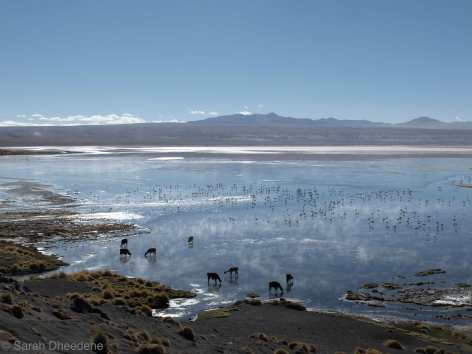
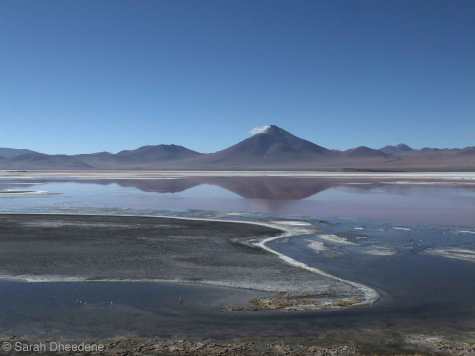
However difficult it was to leave that spot, we had to go back in the car and move on. We stopped at a place which was similar to the Dalí desert, with one particular rock which the wind had shaped like a tree. We couldn’t climb up that one. But we did climb on every other rock in that field. It was one of these moments where you re-discover the child in you and the need to explore a new environment, finding secret passages, a point of view no-one else has spotted,… It was good fun.
We made a third pause at yet another lake. One with many flamingos. However, the most remarkable thing about the place was a sign which said “Wi-fi”. I laughed, thinking Bolivians had a great sense of humour. We were in the middle of the desert. How could there possibly be any internet? But, as it happens, this was not a joke. They were in the process of finalizing some kind of ecological lodging and the wi-fi connection seemed to be part of the services offered by the place. Sad thing, I thought, that people cannot spend four days without being connected anymore… while I was trying to find out if the connection worked and was for free. Yes. That’s probably the saddest part of all.
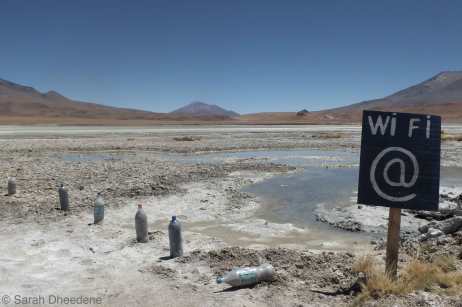
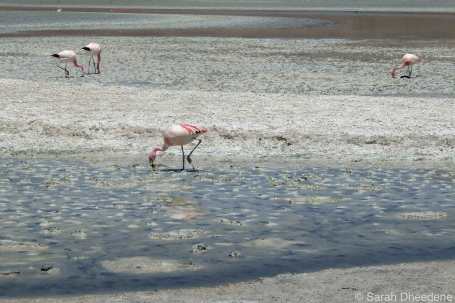
Just when we left, a little fox appeared. I wondered yet again how all these animals managed to survive in such a harsh environment. Nature is definitely and truly amazing.
While we were waiting for our polyvalent driver to finish preparing lunch, we took time to have a look at one of the active volcanoes in the park. Afterwards, we went through a first salt desert. Not quite as big and impressive as I imagined the actual Salar de Uyuni would be but still something very special . As well as the railway that crosses it – my best guess being that is or was used to transport salt – and the two black dogs that suddenly appeared out of nowhere. According to our guide, they belonged to the soldiers of a military post we would come across. Actually, we were stopped there for a control. While we were waiting for the soldiers to come and open the gate, we had a great view of a welcoming red wall with a black skull painted on it. No one ever came, so we opened the gate ourselves. Couldn’t blame those soldiers, really. If I had to live in such a place for a long time, I would probably try to escape as well.
A few kilometers further on, as everything was quite calm – pretty much the same as during the last 72 hours actually – Rubén suddenly braked very brusquely, ran out of the car and threw himself on something. We couldn’t really figure out what it was in the distance. But soon enough, he came back to the car with his trophy: an armadillo. This animal is threatened with extinction and therefore protected. Reason for decreasing populations of armadillo’s is that they were hunted for their meat but also to make music instruments. As he came back with the animal with a very happy face and telling us it was really rare to be able to find one, we thought he brought it back to the car just so we could see it. But then he put it behind his back, squeezing the animal between his body and the seat, and drove off. None of us quite understood why he hadn’t released the poor animal and we felt rather uncomfortable with it, knowing that it was an endangered species. When we asked, it transpired that it was a superstitious thing: finding and catching an armadillo was a sign of good luck and he wanted to take the animal home to have it as a pet for his children. But then we started to wonder if he wasn’t planning to just kill and eat it. Either option wasn’t sounding good, not only because armadillo’s are so rare but also because it might have been a female needing to feed her young. We tried to talk him into releasing it, which he eventually said he was planning to do later on.
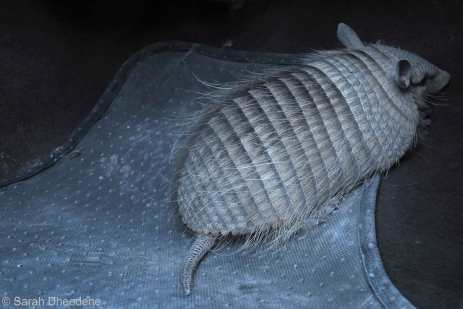
Before getting to the village at the border of the salt flat, where we would spend the night, we made one last stop at the village of San Juan del Rosario. The main attraction there is a pre-Inca cemetery, where the tombs rather look like little huts, inside which you can see the bones of the dead. Pretty weird. Getting out of the necropolis, I spotted a sign with some basic information on how climate change was affecting the landscape but also, and more important, the access to water, production of food, etc. In Europe, we are starting to feel the effect of global warming but it has as yet no effect on the way we live . But it already has in many other parts of the world. Noticing it in circumstances like these is rather confronting. And it made me realize why we often act as if it doesn’t exist. It’s just because the consequences are pretty damn scary. Living like an ostrich is so much easier. We choose short term comfort over long term sustainability. I try to become more conscious about it every day but even so there’s still a lot of work to be done.
Finally, we got to the village where we would spend the night and the hotel held two pleasant surprises. The first one was the hotel in itself. Like many other houses and hotels in the village, it was entirely built with the most readily available material around: salt. Even the tables, benches and beds were built in salt. Together with the hammocks in the desert of La Guajira and the little hut in the jungle in San Cipriano, both in Colombia, it belonged to the most special places I had been sleeping in during this trip. The other interesting thing was that, for less than a dollar, we were allowed to take a hot shower. Considering we hadn’t been able to shower at all during the last three days, except for a plunge into the thermal bath, which involved no soap, that’s something we were all pretty much looking forward to. We went for a little walk before dinner and, when we came back, Rubén told us he had released the armadillo. A good thing. Except that, so far from its original habitat, it might die all the same. Or maybe he just killed it himself anyway. There was no way for us to know, so we just hoped for the best.











